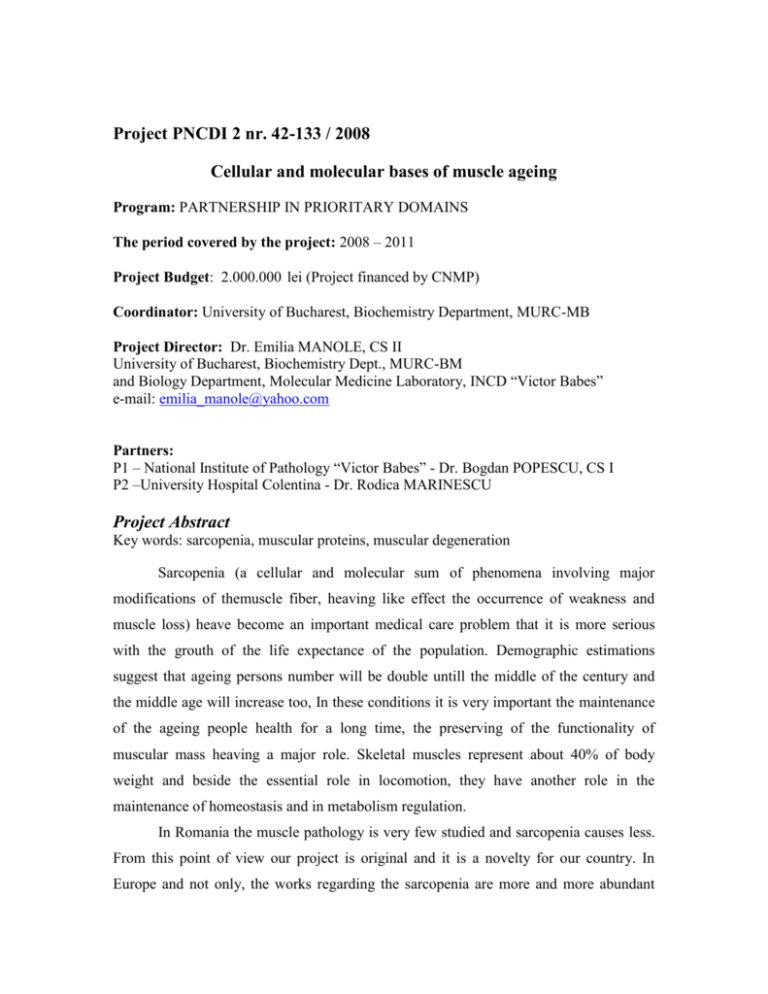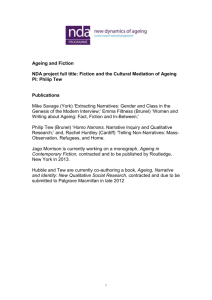Project PNCDI 2 nr. 42
advertisement

Project PNCDI 2 nr. 42-133 / 2008 Cellular and molecular bases of muscle ageing Program: PARTNERSHIP IN PRIORITARY DOMAINS The period covered by the project: 2008 – 2011 Project Budget: 2.000.000 lei (Project financed by CNMP) Coordinator: University of Bucharest, Biochemistry Department, MURC-MB Project Director: Dr. Emilia MANOLE, CS II University of Bucharest, Biochemistry Dept., MURC-BM and Biology Department, Molecular Medicine Laboratory, INCD “Victor Babes” e-mail: emilia_manole@yahoo.com Partners: P1 – National Institute of Pathology “Victor Babes” - Dr. Bogdan POPESCU, CS I P2 –University Hospital Colentina - Dr. Rodica MARINESCU Project Abstract Key words: sarcopenia, muscular proteins, muscular degeneration Sarcopenia (a cellular and molecular sum of phenomena involving major modifications of themuscle fiber, heaving like effect the occurrence of weakness and muscle loss) heave become an important medical care problem that it is more serious with the grouth of the life expectance of the population. Demographic estimations suggest that ageing persons number will be double untill the middle of the century and the middle age will increase too, In these conditions it is very important the maintenance of the ageing people health for a long time, the preserving of the functionality of muscular mass heaving a major role. Skeletal muscles represent about 40% of body weight and beside the essential role in locomotion, they have another role in the maintenance of homeostasis and in metabolism regulation. In Romania the muscle pathology is very few studied and sarcopenia causes less. From this point of view our project is original and it is a novelty for our country. In Europe and not only, the works regarding the sarcopenia are more and more abundant and the medical and scientific authorities are more concerned about ageing persons problems. Our aim is to contribute at the enhancing of the knowledges concerning the cellular and molecular causes of the muscle ageing, heaving in mind future methods for these modifications control and the improvement of life quality for the ageing persons. Because of the consequences of the complex phenomenon of muscle ageing, we propose to study the basical celular and molecular alterations that occur in muscle fiber of ageing people. We shall have muscular biopsies from human subjects with orthopedical surgery interventions, divided on age groups between 20 and 80 years old. The first step will be the analysis of the celular modifications of the skeletal muscle along the life, with hiostological, histochemical, histoenzymological and electron microscope methods. A special attention it will have the mitochondrion and the nuclei, because they are the first affected by the celular distructive processes. The second step will be the analysis of some important citoskeletal and functional protein expression by immunohistochemisty and Western blotting techniques. These proteins are: alpha, beta, gamma and delta sarcoglycans, utrophin, dystrophin, caveolin-3, alpha and beta dystroglycans, talin, vinculin, desmin, alpha actin, myosin heavy chain, calpain 3, nNOS, acethylcholine receptors etc. Apoptoses will be investigated too, by analysis of main apoptotic factors Bcl-2 and Bax. Their fenotipic and genotipic expression will be analyse. In order to investigate the genotypic expression, it will be analyse the mRNA expression by fluorescence-based real-time reverse transcription PCR (RT-PCR). The third step will be a comparison between cellular and molecular data at different aged subjects to see the structural modification occuring in ageing. A correlation with clinical data of the subjects will be established. The final conclusions will bring some new aspects concerning the cellular and molecular modifications in ageing muscle, especially after 50 years, and they will open a way to find methods for an amelioration or a delay in muscular fiber ageing. General and specific objectives of the project: General objective: to determine the cellular and molecular modifications in skeletal muscle ageing, with a special regarding to phenotype expression of the main structural proteins in sarcolemma, costameres, contractile apparatus, neuromuscular junctions, as well as the apoptotic process evaluation, heaving in view some methods to control these modifications and enhancing life quality for the ageing people. Specific objectives: 1. To establish an ageing muscle experimental model of study. Knowing the great complexity of the project and the participant number, it must be established from the beginning the successive steps. Thus, we must trace the tasks for every partner in some work meetings with the project partners leaders. It will be established the subjects groups of study. It will be discussed the ethical aspects regarding the subjects protection data and the modality to take the muscle biopsy in according with the current legislation. 2. Anatomopathological investigations of the muscular biopsies will be done. It will be studied the cellular modifications, especially regarding the mitochondrion, nuclei, myofibrils, glycogen or lipid deposits, connective tissue. Electron microscope investigations will be done also. 3. To introduce the fluorescent immunohistochemical technique (IHF), for establishing phenotype expression of the studied proteins. We would like to see that there are modifications in the quantity and quality of some proteins in different muscle tissue of the different age subjects (proteins of sarcolemma, costamers, contractile myofibrils, cytosol, neuromuscular junctions). 4. To introduce Western blotting technique (WB) for the identification of muscle proteins expression (amount and quality). Calpain 3 will be investigated in the first stage (muscle enzyme that can be investigated only by WB), and also the proteins with an doubtful immunohistochemical expression. It will be examined the proteins modifications in connexion with ageing stage of the muscle. 5. To introduce PCR (RT-PCR) technique for mRNA analysis of myosin-heavy chain, and Bcl-2 and Bax (apoptosis markers). We want to investigate the presence and the intensity of the apoptosis, depending on the subjects age. 6. To validate the experimental model. After all anatomopathological investigation methods and all molecular analysis methods for proteins were done, a complex study regarding the connexions between the modifications occuring in ageing muscle will be accomplished, and a conclusion will be drawn regarding the proposed experimental model. 7. Development of knowledges in medical sciences, genetics and molecular biology. 8. Specialists team development. 9. To balance out levels in medical services domain of our country and other european counties 10. To build-up a research network with an excellence level. Dissemination: SCIENTIFIC MEETINGS 1. Gisela Gaina, Aura Mihalcea, Emilia Manole, Elena Ionica - Molecular diagnoses of dystrophin gene mutation using MLPA, 1st International Conference 2008 of the Cyprus Society of Human Genetics, Nicosia, Cyprus. 2. Gisela Gaina, Emilia Manole, Elena Ionica – Molecular analyses of sarcolemal proteins in LGMD, al 6-lea Simpozion National de Patologie, “Patologie celulara si moleculara” si Sesiunea Anuala a Institutului National “Victor Babes”, 3-5 noiembrie 2009, Bucuresti 3. E. Manole, G. Gaina, B. O. Popescu - General indications for the muscle biopsy, al VIII-lea Congres al Societatii de Neurologie din Romania, 19-22 mai 2010, Bucuresti







